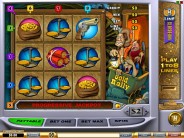
What are the Odds of Hitting a Progressive Slot
Perhaps just as common a question on progressives as how the jackpot hits: Is it worth my time? What are the odds I’ll hit the big one? The answer depends on the progressive, but you can be sure Frank Legato is recognized nationally as an expert in the history and operations of slot machines. He regularly conducts seminars for both the professional trade and the playing public. Frank shares his 20 years of researching, writing about, and playing the slots in his book How to Win Millions Playing Slot Machines! ... or Lose Trying. of one thing: The larger the amount at which the jackpot resets, the longer the odds are of hitting it. A single-machine or local-area progressive of a thousand or two is going to hit with pretty good frequency. Of course, on video poker, the odds are already known: around one in 40,000 for the royal flush on a Jacks-or-better progressive. You can expect the odds to be similar on a progressive slot machine with a jackpot around the same level.
Frank Legato is recognized nationally as an expert in the history and operations of slot machines. He regularly conducts seminars for both the professional trade and the playing public. Frank shares his 20 years of researching, writing about, and playing the slots in his book How to Win Millions Playing Slot Machines! ... or Lose Trying. of one thing: The larger the amount at which the jackpot resets, the longer the odds are of hitting it. A single-machine or local-area progressive of a thousand or two is going to hit with pretty good frequency. Of course, on video poker, the odds are already known: around one in 40,000 for the royal flush on a Jacks-or-better progressive. You can expect the odds to be similar on a progressive slot machine with a jackpot around the same level.
On the other end of the spectrum is the super life-changing jackpot on a wide-area progressive. This one’s a bit trickier to calculate, since, unlike the state lottery — which prints the odds on the backs of the ticket — the casinos are not required to publicize the odds of hitting the top jackpot on a progressive slot machine. The only way to know is to look at the “par sheet” of a game, which lists the probabilities of each paying combination. Casinos get these from the manufacturers, but they are not available to the general public. But the odds of the hitting the largest ones are generally one in tens of millions.
One of my gaming-writer colleagues, slot expert John Robison, got his hands on a par sheet for Megabucks, and reported the odds of hitting the big one on that game last year in his column on the “Casino City Times” website (which I recommend highly, by the way). According to John, the odds of getting your picture taken grinning behind a big Megabucks check is one in 50 million.
One thing that is public knowledge concerning progressive odds is the overall payback percentage. On the base game, the larger jackpots mean the long-term payback percentage is going to be several points lower than on a similar stand-alone slot. If a stand-alone slot game returns 92 percent over the long run, its progressive counterpart is likely to return 88 or 89 percent. That means fewer jackpots on the base game. It’s required to fund that big jackpot, and it’s a tradeoff that progressive slot enthusiasts are normally willing to make.
Don’t forget—to get the full return and odds to go in your favor on the vast majority of progressive slots, you will have to bet maximum coin. There are some new multiline games from a couple of manufacturers on which you can win a progressive without betting the max, but they are few. For most of them, you’ve got to pony up the max bet.

